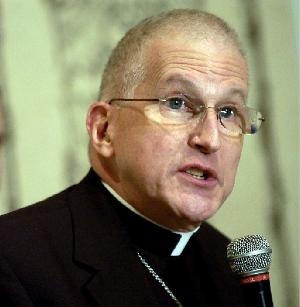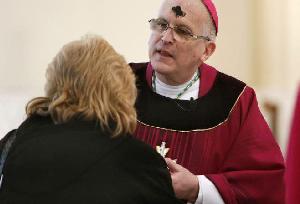By Mark Guydish
Times-Leader
August 29, 2009
http://www.timesleader.com/news/Martino_era_expected_to_end_08-29-2009.html
 |
| Joseph Martino is expected to resign Monday after serving for six years as the bishop of the Diocese of Scranton. Photo by Don Carey |
SCRANTON – Bishop Joseph Martino is expected to resign next week, making his tenure the second shortest among all leaders in the Diocese of Scranton, and leaving behind a flock divided after shrinking finances and a dwindling number of priests prompted him to close numerous schools and churches during his tumultuous, six-year service.
Sources in and outside the diocese confirmed on Friday that Martino, 63, and Auxiliary Bishop John Dougherty, 77, will resign and that Archdiocese of Philadelphia Cardinal Justin Rigali will be appointed Apostolic Administrator until a new bishop is chosen by the pope. Dougherty actually submitted his resignation when he turned 75 as required by the church, but it was never acted upon. Rigali is the “metropolitan” in Pennsylvania, meaning he is the highest ranking bishop in the state.
Despite the fact that multiple media outlets locally and nationally reported Martino’s looming resignation throughout the day, the diocese officially kept mum, posting a terse notice on its Web site Friday afternoon titled “Diocese of Scranton to make announcement.”
The diocese will hold a news conference Monday at 10 a.m. According to the notice, “the event is not open to the public and the location cannot be disclosed,” though diocesan spokesman Bill Genello said secular media can attend. The conference will be broadcast on the diocesan TV station, Catholic Television, and then posted on the diocesan Web site. Friday’s statement ended with a succinct promise that nothing more will be forthcoming: “There will be no comment from the diocese prior to the news conference.”
A Philadelphia native with a widespread reputation of being both scholarly and affable, Martino had risen to the post of auxiliary bishop in his native diocese before being picked to succeed Bishop James C. Timlin here in 2003. In Philadelphia, he had often been the voice of the diocese, providing comments and commentary for local radio and TV stations. During his early days here he seemed equally accessible, but as he faced knotty issues and made decisions that frustrated and angered many, he increasingly opted to communicate only through diocesan media.
Martino had the misfortune of taking over a diocese that had grown rapidly for more than a century but had started to decline in recent decades. The number of Catholics shrunk in the bastion counties of Luzerne and Lackawanna and grew in places like Pike and Monroe counties. The number of priests plummeted from a high of 420 in 1970 to 220 in 2005, and is projected to drop to 160 in coming years.
Annual financial reports got gloomier each year, as Martino cited operating deficits and budget shortfalls, insisting they left him with little choice but to curtail many diocesan programs, close schools and consolidate churches.
 |
| Bishop Joseph F. Martino distributes ashes during an Ash Wednesday Mass to a standing-room-only congregation at St. Peter’s Cathedral in Scranton. Ash Wednesday marks the beginning of Lent. Photo by Bill Tarutis |
Martino did have initial success in improving donations to the Diocesan Annual Appeal, which collected $4.3 million his first year and climbed to an all-time high of $6 million in 2007 before starting a slide to $5.4 million in 2008 and $5 million this year. This came despite the fact that he took over only a few years after the diocese had dealt with a string of scandals involving sexual misconduct by priests, a scandal that angered many faithful, some of whom said they reduced or eliminated their donations to the Appeal.
Martino had, in fact taken one step in the resolving the scandal that his predecessor had not: Suppress the Society of St. John, a group that had set up in Pike County and that had several members repeatedly accused of misconduct. The Society left the diocese and reappeared in South America.
If there was any single turning point in his career here, it was the restructuring of schools throughout the 11-county diocese, begun in January 2006. A preliminary recommendation made public in November that year called for the closing of four Luzerne County high schools and merging them into one, as well as closing many elementary schools, some in existence since the early 1900s.
Many parents were outraged, insisting their efforts to save the high schools – complete with promises to raise hundreds of thousands of dollars – fell on deaf ears in Scranton. Groups were formed and appeals were sent to Rigali in Philadelphia and the Apostolic Nuncio, or papal embassy, in Washington, D.C. Some activists urged people to stop putting money in church collection baskets. At a meeting that drew about 250 people they circulated “Martino money,” fake bills with the bishop’s face.
Martino stood firm when he announced the final decision in February 2007, and those groups eventually faded, but a bigger fight loomed with the Scranton Diocese Association of Catholic Teachers, or SDACT, a union that had represented teachers under the old school system and asked to do so again after restructuring. When that request was rejected in January 2008, the union responded by staging informational pickets, rallies and sick-outs that closed individual schools for a day.
Martino again stood firm, but the union didn’t go away, ultimately getting state Rep. Eddie Day Pashinski, D-Wilkes-Barre, to help introduce a bill that, if it became law, would give Catholic and other religious school teachers protection under the state Labor Relations Board, something the state Supreme Court had ruled they do not have. That bill is still in committee.
SDACT President Michael Milz welcomed the news of Martino’s expected resignation and encouraged any replacement to mend fences with union labor.
“I don’t think it’s an exaggeration to say all of Bishop Martino’s problems stem from the union battle. Prior to busting the union, for the first few years he had relatively smooth sailing,” Milz said. “Bishop Martino was insensitive to the pro-labor sentiment the diocese has held here in the past.
“Unless the new bishop rectifies the damage to the labor community, I don’t see him having any more success than Bishop Martino did. We will be willing to reach out our hand and offer to cooperate.”
The school restructuring had barely been concluded before Martino launched a similar, year-long review of all churches that led to the announcement that about half the churches diocese-wide will close. The news was met with a more muted public response, but eight churches appealed, most of them going so far as to take their appeals to Rome, despite the expense.
Anthony and Noreen Foti, who have spearheaded a rigorous effort to save Sacred Heart church in Wilkes-Barre, said they “are encouraged at the prospect of a new bishop.” According to their numbers, a total of 29 parishes had been suppressed, or closed in diocesan history before Martino took over. Since then, Martino has either already closed or announced the closing of up to 115 parishes.
“It’s unprecedented,” Noreen Foti said.
If Martino resigns, “It is a chance to repair some of the damage that has been done,” Anthony Foti said. “We hope a new bishop will meet with the groups appealing closure and hear their cases.”
Martino made other decisions that sparked controversy. As part of the school restructuring, he required religious sisters who intended to continue teaching to provide a letter from a priest saying they were Catholics in good standing. Such sisters belong to religious orders not under direct diocesan control. Traditionally a quiet, devout group, few objected publicly but some did complain privately. One, Sister Regina Werntz, resigned and moved out of the diocese, sending a letter to area newspapers citing that new requirement as a key reason.
The bishop also questioned the availability of contraceptives at Catholic colleges in Luzerne and Lackawanna counties, suggested that Misericordia University close its Diversity Institute after a gay rights activist and author had been hosted for two days, and asked Misericordia to provide public evidence it fulfills its responsibilities as a Catholic institution. The colleges asked for a private audience to discuss the matters, but Martino steadfastly insisted they provide the information he sought, first.
Martino won accolades from many traditional Catholics for his hard-line stance against abortion, voiced repeatedly in public statements and letters to prominent politicians like U.S. Sen. Robert Casey. The bishop also has been praised by many for hewing so closely to traditional Catholic doctrine in the face of all the controversy.
While some have speculated that Martino is being nudged out by those higher up in the church hierarchy as a result of all the division and debate spawned by his actions, a source told The Times Leader that Martino has had health issues in recent months that could have contributed to any decision on his status.
Bishops in Scranton
Here’s a list of Diocese of Scranton bishops, the year installed, years in office, and how each tenure ended.
William O’Hara, 1868, 31 years, died in office
Michael J. Hoban, 1899, 27 years, died in office
Thomas C. O’Reilly, 1928, 9 years, died in office
William J. Hafey, 1937, 17 years, died in office
Jerome D. Hannan, 1954, 11 years, died in office
J. Carroll McCormick, 1966, 17 years, retired
John J. O’Connor, 1983, 1 year, transferred
James C. Timlin, 1984, 19 years, retired, current bishop emeritus
Joseph F. Martino, 2003, six years, expected to resign.
Mark Guydish is a Times Leader staff writer. Contact him at 829-7161.
Contact: mguydish@timesleader.com
Any original material on these pages is copyright © BishopAccountability.org 2004. Reproduce freely with attribution.